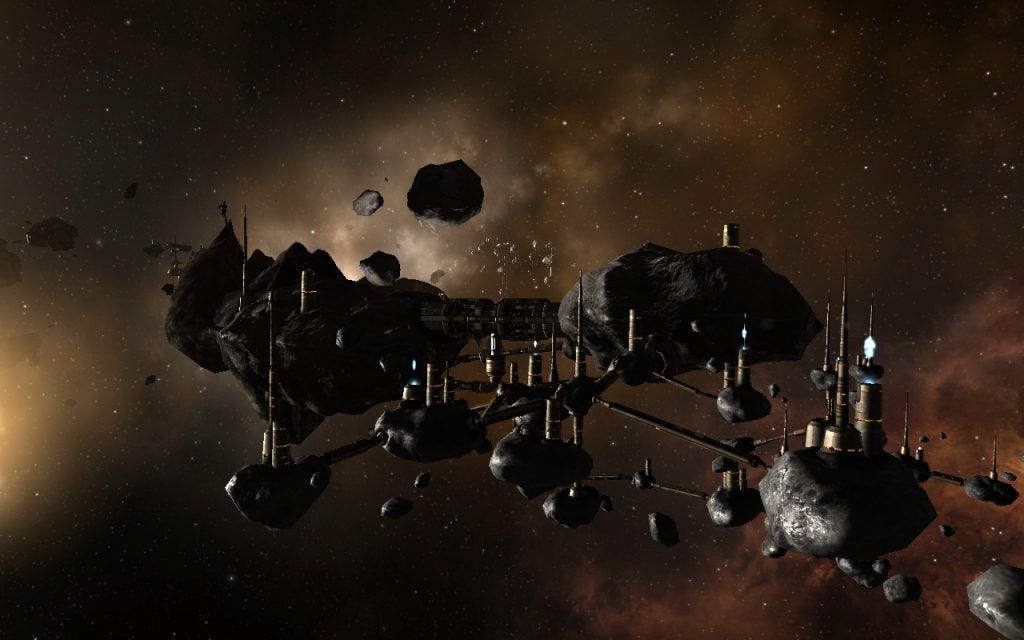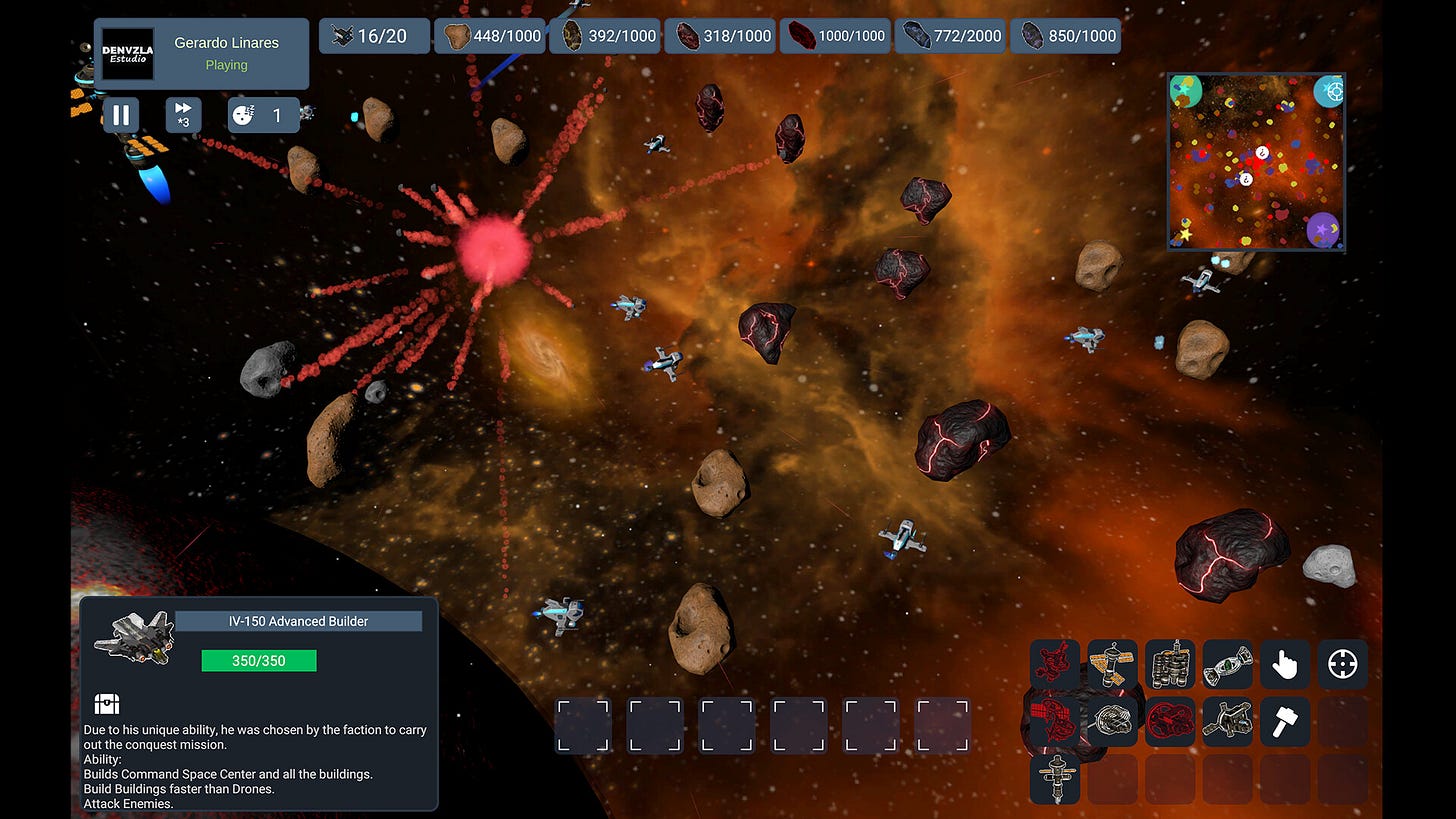As I promised in the previous post, I will talk about more hopeful futures—how cybernetic ideas and cliodynamic technologies can help us steer societies in more positive directions. But before doing that let’s consider a really dystopian scenario. What follows is science fiction (in fact, I’ve encountered many elements of it in various sci-fi novels I’ve read over the years). So, here it goes.
In a near future some corporations will start sending uncrewed space craft to the asteroid belt. The goal would be to start mining it for various elements. The next step is to send there a robotic factory that will use these resources to build various things—other harvesters, solar panels for energy, and most, importantly, additional production factories.
Why asteroids, rather than other planets, like Mars, or satellites, like the Moon? Because the major initial investment in getting such a program started is simply getting spacecraft into the Earth’s orbit. Compared to escaping the Earth’s gravity well, all other movements within the Solar system are cheap (asteroids have no gravity to speak of).
Some years ago, I was at a Sci-Foo meeting on Google Campus, and one of the most interesting panels there featured two really knowledgeable people from NASA and a couple of academics. Their unanimous verdict was that getting to and exploiting asteroids is actually how the humanity will reach the stars. Mars missions and the such are a distraction and waste of resources.
An asteroid factory (source)
The most likely individual leading this program is, of course, Elon Musk (I am sure he already has detailed plans), because his various enterprises control all the needed technologies, from space flight to robots to AI. But others will follow in short order.
What happens next? As more harvesters, energy panels, and production facilities are produced, they will build even more of themselves. The result is exponential growth of production capacity.
Different corporations in the asteroid belt will inevitably compete against each other (perhaps for some asteroids with rare elements, or simply to reduce the rivals’ market shares). What’s to prevent them from building military spacecraft to shoot down the rival’s production capacity? Nothing. There are no laws out there, no space police to enforce any such laws, even if they were agreed upon, and, in any way, no people would be killed, just some property destroyed.
Once conflicts start in such an anarchic system, they will spread and space wars will involve all corps out there. Whoever has initial advantage (in building up productive capacity, or first switching to producing warships) will likely win. It’s a game of winner-take-all.
If any of you have played a space exploration and conquest computer game, you are intimately familiar with this logic. In most such games you cannot simply relax and leisurely build up your empire, because inevitably one of your opponents (AI or human) would eventually appear on your horizon with an overwhelming force and wipe you out. No, the name of the game is race, baby, race. You have to increase your productive (and later military) capacity faster than your rivals.
Once one corporation destroys all its competitors we come to the really dystopic part. What’s to prevent the Ultimate Space Lord (the CEO of this corporation) to come back to Earth and build orbital stations capable of bombarding Earth’s surface? At that point we will have an unassailable Supreme Dictator/Space Tyrant and our fates (or fates of our children) would entirely depend on how benevolent (or not) this person is.
What does cliodynamics and cybernetics have to do with this science fiction? Remember, one key idea in both is the importance of feedback loops. Feedbacks come in two basic varieties: positive and negative (there are more types depending on nonlinearities and time delays, but let’s stay with the basic kinds for simplicity sake). The game of space exploration and conquest is characterized by positive feedback. More generally, warfare has the same dynamic. Warfare on the Earth surface eventually runs into negative feedbacks due to logistic constraints, but in space such potential constraints are far away, and the positive feedback rules.
Interestingly, the economic AI game is very different. Noah Smith recently wrote an interesting post, in which he asks, Who will actually profit from the AI boom? Let me restate the part of his argument, which is relevant to my post. Smith argues that there are no natural limits to the entry into the AI industry. All you need is to borrow enough money, attract the necessary talent to write models, train models on data (from the public internet), and build up computational capacity. As more and more firms enter the market, they will drive profits for everybody (both early and late entrants) down to zero. At which point all sources of capital would dry up (who wants to invest for 0% return?) and the industry will enter the state of “involution.”
In other words, the game of economic competition is characterized by negative feedback loops—unlike warfare that is driven by positive feedback. To escape involution, an AI firm would have to escape Earth—go into space and then follow my sci-fi scenario.
OK, to bring this post to an end, what is my personal opinion on this “really dystopic” scenario? I think that all technologies needed for it are either already available, or will be developed in near future—except one. A robotic complex for asteroid mining, manufacturing, and warfare will need a real AGI (Artificial General Intelligence). The task of developing such a conglomerate is too complex and requires creativity. Do we have such AI, or if not, how likely are we to develop it in the near future? Sam Altman thinks that it’s just a few years before we have robots building robots (see Sam Altman Predicts Transformative AI Future: Superintelligence and Robotics by 2030). But in a recent post (The Rage of the AI Guy) Freddie Deboer does a pretty good job dismantling the hype. So, perhaps we can relax for a while.




And with respect to the Sun’s gravity well, your Ultimate Space Lord of the asteroids has the high ground in any conflict with Earth, literally. So too would any Lord of Mars. As Robert Heinlein observed in his “The Moon is Harsh Mistress” (Elon’s a fan), all your USL need threaten is to “roll” some of those rocks “downhill” and let orbital mechanics do the rest. Asteroids, the size of boulders becomes the equivalent of nuclear weapons when they enter the atmosphere at high velocity.
Interesting article and learned about asteroid mining and “AstroForge”, “involution”, and am curious about evolving “space law”. Good article and comments.